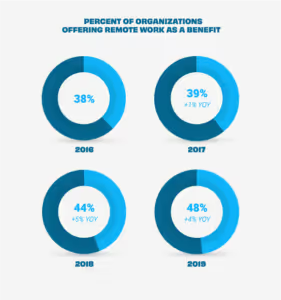Looking for Payscale’s 2021 State of Remote Work Report? Get the data and insights now.In the future, more employees will work from home. That was a certainty before 2020, as the data has been trending in the direction of increased remote work opportunities for years. However, following the COVID-19 pandemic, remote work opportunities are set to explode. Where businesses were once reluctant to offer remote work, many are now scrambling to make remote work opportunities permanent.But do you know how to pay remote workers? Is it unfair if team members contributing the same value on the same project are paid differently based on where they live? Does cost of living matter and can you use a cost of living calculator to adjust pay for a remote position in an area where you don’t have market data?Getting pay right for remote workers requires a thoughtful and well-articulated approach to compensation. Indeed, without a compensation strategy articulating the purpose and process for setting pay for workers, remote or otherwise, an organization is at risk for paying workers unequally, unfairly, or noncompetitively.To get at the right compensation strategy for how to pay remote workers, you’ll need salary data, and specifically salary data for geographical areas beyond your current headquarters or office locations. Minimally, this will allow you to model different scenarios with your finance team and align on desired business outcomes.PayScale’s compensation management software provides this data as well as a wealth of insight and reporting tools. PayScale also has dedicated customer support teams and professional services to help you form a compensation strategy for the future and communicate your direction effectively and transparently throughout your organization.
Remote Work Had Been Trending Up for Years
The outbreak of Covid-19 didn’t start the trend toward remote work, but it did accelerate it. According to PayScale’s Compensation Best Practices Report, remote work has been growing in popularity as part of an organization’s benefits and total rewards package year over year.

Employees are largely in favor of remote work. In 2020, Global Workforce Analytics estimated that 56 percent of the U.S. workforce held a job that was compatible with remote work. They also found that 80 percent of the U.S. workforce wanted to be able to work from home and would turn down a job offer that didn’t offer flexible working conditions.Despite this, only 3.6 percent of the total employee workforce worked remotely half the time or more before the COVID-19 pandemic. It is employers who have approached remote work skeptically — at least until Covid-19 forced the issue.Employers have now realized that remote work is not less productive than work in an office. Indeed, there is a positive correlation in increased productivity associated with working from home. According to a survey from Global Workplace Analytics, employees are productive 75 percent of the time they are working from home compared to 63 percent of the time in the office. Another way to look at it is that employees are distracted 78 minutes of the day in an office and only 43 minutes in the day when working from home.
Does Shifting to a Remote Workforce Equate to Cost Savings?
According to a Gartner survey from March of 2020, 74 percent of CFOs want to transition at least 5 percent of the workforce to permanently remote positions. 25 percent of respondents want to shift 20 percent of the workforce to permanent remote positions. The objective of a distributed workforce is ostensibly to decrease payroll expenses. However, CFOs shouldn’t assume that a remote work strategy will save their organization money. This is why the question of how to pay remote workers is so important to get right.Payscale’s research into salary data in 2020 revealed that remote workers are paid more overall than people who work in an office. Specifically, remote workers were found to make 0.6 percent more than non-remote workers with the same experience doing the same job (controlled) and seven percent more than non-remote workers generally (uncontrolled).It is important to note that remote workers are not paid more because they work remotely. Rather, it is more likely that remote work opportunities currently tend to be reserved for high performers who have earned trust to work from home.As such, CFOs shouldn’t assume that a remote workforce will necessarily result in cost savings, at least not as far as payroll is concerned. Of course, there are cost savings to be realized from a remote work strategy that have nothing to do with compensation. For example, businesses could save money by shrinking their office space, reducing commuter benefits, and cutting expenses associated with workplace meals and other perks that are attractive benefits in an onsite work environment.Then again, organizations may find that there are new expenses associated with supporting a remote workforce that were not expected when employees work in an office. This could include providing employees with:
- Computers, monitors or other home office equipment
- Stipends for internet connectivity
- Upskilling or reskilling to help employees thrive in a remote work environment
- Collaboration software and other cloud-based technology
- Programs to create and maintain culture outside of an office
- New or increased security measures and training
- Technology for employees to “check in” work or to monitor employee productivity
- Travel stipends to support in-person events or workshops
In other words, cost savings associated with a remote workforce needs to be budgeted for based on the organization’s compensation strategy, talent strategy, and the needs of the workforce. To do this, HR will need access to as much data as possible — including salary data — that allows them to model different scenarios for the CFO.
Cost of Living is Not a Good Way to Set Pay for Remote Workers
One strategy for how to pay remote workers is to apply a cost-of-living adjustment (COLA) to a position in a new location based on a benchmarked salary range for a location where you currently have market data. However, this is not a best practice.Cost of living is calculated based on the Consumer Price Index, which measures the average change over time in prices for consumer goods in an urban market. You can use PayScale’s COLA calculator to see how moving a position to a new city will impact the purchasing power of that employee.However, rises in cost of living do not always reflect in wages. Therefore, basing remote work compensation on cost of living will almost assuredly result in overpayment or underpayment for a position. For example, an organization based in San Francisco and considering a customer service center in Milwaukee may calculate the cost of living in Milwaukee as 46 percent less than San Francisco and conclude that salaries for employees living in Milwaukee should be 46 percent less than salaries in San Francisco. However, this conclusion would be erroneous.Let’s look at a few examples. In our State of Remote Work Report for 2020, we took some of the most common remote work positions and compared the national median for each position according to PayScale’s Crowdsourced data to the median of that job in a specific metro city using PayScale’s Crowdsourced data as well as the corresponding COLA adjustment. As you can see, the median pay for a position differs by metro area and does not correspond to COLA. Adjusting pay according to cost of living, especially in a major metro area compared to the national median (note: PayScale’s Crowdsourced data includes more rural markets and smaller company sizes than traditional surveys), tends to result in significantly higher pay.
<a href='#'><img alt=' ' src='https://public.tableau.com/static/images/Re/RemoteWorkerPay/RemoteWorkerPay2/1_rss.png' style='border: none' /></a>
*The data in this chart is based on PayScale Crowdsourced Data. PayScale also provides Company-Sourced Data and access to Third-Party Market Surveys for a full and validated view of pay ranges for any position in just about any market.
NOTE: COLA tends to be used in the compensation industry to refer to pay adjustments (raises) that are not actually based on the consumer price index or salary market data. Many organizations will budget yearly salary increases of 2 or 3 percent and refer to it as a cost of living adjustment (COLA) without actually researching how cost of living has increased by geographical area or how the competitiveness of a specific job has changed in a specific area. Organizations with a more mature approach to compensation management will research salary data for each of their job families within a given market on a regular basis and recommend pay increases based on this data with the corresponding pay communications that explain why it is an appropriate adjustment based on actual market changes.
How to Pay Remote Workers by Industry and Occupation
Although remote workers earn more than non-remote workers at the national median, the results are mixed when analyzing remote worker pay across industry and occupation. This data can be useful to organizations evaluating how to set pay for remote workers as it can indicate trends in workers who expect to earn the same or more when working from home and workers who might be willing to take a pay cut for the convenience of working from home based on their industry or occupation.Generally speaking, we see that remote workers in highly professional, white collar industries receive higher pay relative to non-remote workers while other industries see modest decreases in pay for remote work. The more skilled and educated the profession, the more likely pay for remote workers will be higher compared to non-remote workers. For example, industries where remote workers receive higher pay include Engineering & Science, Technology, and Arts, Entertainment & Recreation.Meanwhile, industries such as Construction, Energy and Utilities, Real Estate, and Transportation and Warehousing see lower pay associated with remote work positions, most likely because the core positions within these industries are required to interact with customers, equipment, or teams onsite and where remote workers may be viewed as receiving special accommodation as a compensable benefit.INDUSTRYMEDIAN PAY:REMOTE WORKERSUNCONTROLLED MEDIAN PAY:NON-REMOTE WORKERSUNCONTROLLED % DIFFERENCECONTROLLED MEDIAN PAY:NON-REMOTE WORKERSCONTROLLED % DIFFERENCEOverall$48,500$45,1007.0%$48,2000.6%ACCOMMODATION & FOODSERVICES$28,100$29,900-6.4%$28,0000.4%AGENCIES & CONSULTANCIES$57,200$47,00017.8%$55,9002.2%ARTS, ENTERTAINMENT &RECREATION$39,500$39,600-0.3%$38,3003.0%CONSTRUCTION$45,100$49,900-10.6%$45,900-1.7%EDUCATION$49,400$46,2006.4%$48,5001.8%ENERGY & UTILITIES$58,200$58,900-1.2%$58,500-0.4%ENGINEERING & SCIENCE$78,800$58,60025.7%$75,6004.0%FINANCE & INSURANCE$62,800$47,70024.0%$61,7001.8%HEALTH CARE$36,800$45,300-23.2%$36,900-0.4%MANUFACTURING$50,400$49,0002.8%$50,4000.0%NONPROFITS$46,200$40,80011.7%$44,9002.7%REAL ESTATE & RENTAL/LEASING$43,300$43,900-1.5%$43,500-0.6%RETAIL & CUSTOMER SERVICE$30,700$31,700-3.2%$30,700-0.1%TECHNOLOGY$81,300$58,30028.3%$78,8003.1%TRANSPORTATION & WAREHOUSING$44,100$46,100-4.5%$44,600-1.2% The same general trend is seen at the occupation level. Highly educated white-collar positions requiring unique professional skills see higher pay for remote workers versus non-remote workers, especially in Media & Publishing, Marketing & Advertising, Sales, Information Technology, and Human Resources.Occupations to experience a modest reduction in pay for working remote include Manufacturing & Production, Construction, Installation, Maintenance & Repair, and Transportation. Generally, these are occupations where most positions must be onsite at least part of the time and where remote work may be a rare or special accommodation. OCCUPATIONMEDIAN PAY:REMOTE WORKERSUNCONTROLLED MEDIAN PAY:NON-REMOTE WORKERSUNCONTROLLED % DIFFERENCECONTROLLED MEDIAN PAY:NON-REMOTE WORKERSCONTROLLED % DIFFERENCEACCOUNTING & FINANCE$63,900$57,40010.2%$62,4002.3%ADMINISTRATIVE & CLERICAL$36,800$37,300-1.3%$36,800-0.1%ARCHITECTURE & ENGINEERING$64,000$63,7000.5%$63,4000.9%ART & DESIGN$49,600$45,0009.4%$47,8003.6%CONSTRUCTION$44,500$50,400-13.3%$45,200-1.5%FOOD SERVICE & RESTAURANT$27,100$28,400-4.5%$27,0000.5%HEALTHCARE PRACTITIONERS & TECHNICAL$50,600$57,600-13.8%$50,6000.0%HUMAN RESOURCES$61,800$53,20013.8%$59,4003.9%INFORMATION TECHNOLOGY$84,700$64,00024.5%$80,9004.5%INSTALLATION, MAINTENANCE & REPAIR$42,500$44,500-4.7%$43,000-1.1%LEGAL$49,300$47,8003.1%$49,500-0.5%MANUFACTURING & PRODUCTION$38,300$41,500-8.4%$39,100-2.2%MARKETING & ADVERTISING$78,100$58,10025.6%$73,8005.4%MEDIA & PUBLISHING$55,700$45,90017.6%$52,5005.7%RETAIL$27,000$28,400-5.3%$27,000-0.1%SALES$73,200$46,50036.5%$69,5005.1%SCIENCE & BIOTECH$58,600$53,4008.8%$57,6001.8%SOCIAL SERVICE$44,100$43,9000.6%$44,0000.1%TRANSPORTATION$35,700$36,600-2.6%$35,900-0.5%
Top Strategies for How to Pay Remote Workers
Knowing the national median by industry and occupation for remote workers compared to non-remote workers can help your organization form a general strategy around how to pay remote workers, but it can’t tell you what to pay workers in specific positions that may be remote or how transitioning certain positions to remote work will impact payroll. To do that, you first have to develop a compensation strategy for remote employees that aligns to your compensation strategy as an organization in general.There are a limited number of options to go about determining how to pay remote workers:

Base Remote Worker Pay on the Employer’s Location

Base Remote Worker Pay on the Employee’s Location

Base Remote Worker Pay on a National MedianYou could also set pay by grouped regions with similar pay bands, sometimes called pay zones. Each of these strategies has strengths and weaknesses. Selecting the best approach will depend on your overall compensation strategy to attract and retain talent as well as your location, industry, and the size of your organization — often in that order.For specific information about the pros and cons of each strategy, download our whitepaper: How to Formulate a Remote Work Pay Strategy.
Taking Location into Account in Setting Pay for Remote Workers
At PayScale, we talk a lot about the importance of paying employees according to the market. Generally, this is a smart approach to compensation management that ensures employees are paid fairly according to all compensable factors, of which location-based pay and geographic differentials is a major one.However, there are some valid criticisms to paying by location when applied to remote work. For example, you may not want to invest in a compensation strategy where workers providing the same value in the same job are paid differently than employees who work in more or less expensive locations. This is particularly concerning at the hyper local level where employees might be threatened with pay cuts for living in a suburb versus living in a city, but it can also impact teams that are distributed nationally or globally depending on how compensation is determined and how the strategy is communicated to employees.Providing higher compensation to employees who live in more expensive areas could also widen the wealth gap and even come to be viewed as a type of discrimination. This is especially true for organizations looking to save on payroll expenses by issuing pay cuts to workers who live in less expensive zip codes.At the same time, it is impossible to deny that some positions are more competitive in some areas of the country than others and that cost of living is a factor in making sure pay is competitive enough to attract top talent. After all, people work to live and living expenses vary depending on location. Therefore, using a national median for compensation regardless of employee location may not be an effective strategy for more competitive positions in competitive markets.
The Ethics of Fair vs. Competitive Pay
When determining how to set pay for remote workers, it is important to think about compensation holistically. You should consider the difference between equal pay, fair pay, and competitive pay as these are not always the same and some strategies may not entice the talent you are looking to attract.Equal Pay ≠ Fair Pay ≠ Competitive PayFor example, paying the national median for a specific job regardless of location will allow you to pay workers equally, but that may not be enough to attract and retain competitive talent if you are wanting to hire highly educated and uniquely skilled candidates living in expensive cities. Even if your positions are less specialized, your pay philosophy and compensation strategy should align to the values of your business and talent acquisition and retention goals. For example, you may want to make sure you are paying a living wage rather than the minimum wage if you want your compensation to be viewed as fair and not just equalized.Many organizations are grappling with these questions for the first time as they try to navigate how to set pay for remote workers. Organizations with a mature approach to compensation will try to balance the going rate of human capital with a philosophy that constitutes fair and competitive pay for their business. But the opportunity is bigger than cost savings. The shift to remote work is also an opportunity to tap into a workforce that has been hitherto underutilized, to recruit from a larger pool of talent, to diversify the workforce, and to offer more flexibility and work/life balance to employees.
Get Pay Right for Remote Workers with Payscale Compensation Management Software
Compensation is a critical and strategic part of managing the workforce. The right compensation strategy can increase candidate acceptance offers, lower unproductive turnover, engage employees and motivate workers to perform at their best, especially when tied to merit raises, incentive pay and career pathing. However, many organizations do not have mature processes for managing compensation competitively or a philosophy for paying workers fairly and equitably.The shift to remote work is causing many organizations to consider more deeply how they manage compensation and invest in market data to set compensation accurately using national medians or specific location differentials.Compensation management software can save HR and compensation professionals considerable time and expense in getting pay right no matter where employees are located. PayScale’s Differentials Engine also gives organizations the ability to adjust pay according to both geography and hot skills.Looking for more guidance? Download our whitepaper on How to Formulate a Remote Work Pay Strategy to gain insight into different compensation strategies for a remote workforce and which is right for your organization.Ready to learn what compensation management software can do for you? Contact us for a demo.





.avif)
